
Customer loyalty programs for service businesses are game-changers in today’s competitive market. At Reward the World, we’ve seen firsthand how these programs can transform client relationships and boost profitability.
Service businesses face unique challenges in retaining customers, but a well-designed loyalty program can make all the difference. In this post, we’ll explore the best practices for creating and implementing effective loyalty strategies that keep your clients coming back for more.
Why Customer Loyalty Matters in Service Businesses
The Essence of Customer Loyalty
In the service industry, customer loyalty stands as the cornerstone of business success. It transcends mere repeat business; loyal customers become brand advocates who attract new clients. At its core, customer loyalty in service businesses means clients consistently choose your company over competitors, even when presented with alternatives.
The Financial Impact of Loyal Customers
Loyal customers prove invaluable to businesses. Research shows that increasing customer retention rates by just 5% can lead to a 25% to 95% increase in profits. This statistic underscores the immense value of loyalty programs.

Research from Rosetta Consulting further supports this notion. Engaged customers purchase 90% more frequently and spend 60% more per transaction. They also exhibit a fivefold likelihood of choosing the same brand for future purchases. These figures paint a clear picture: investing in customer loyalty directly impacts the bottom line.
Unique Challenges for Service Businesses
Service businesses face distinct obstacles in customer retention. Unlike product-based companies, service providers grapple with intangibility and inconsistency. Customers cannot touch or see what they purchase before committing, which makes trust-building paramount.
The ease of switching providers presents another significant hurdle. In many service industries, competitors remain just a click away. This reality highlights the importance of personalization. An Epsilon study found that 80% of consumers prefer to do business with companies offering personalized experiences. A tailored loyalty program can serve as the differentiator that prevents customer attrition.
Technology: The Loyalty Game-Changer
In today’s digital landscape, technology plays a pivotal role in fostering customer loyalty. Mobile apps, for instance, have revolutionized customer engagement. Starbucks’ loyalty app exemplifies this trend, driving 40% of the company’s transactions in the U.S. Service businesses can create enduring customer relationships by offering convenience and personalized rewards through such technological solutions.
Data analytics emerges as another powerful tool in the loyalty arsenal. Through analysis of customer behavior and preferences, service businesses can anticipate needs and offer proactive solutions. This level of service not only retains customers but transforms them into brand ambassadors. A Deloitte report indicates that companies adopting a customer-centric, data-driven approach achieve 60% higher profitability compared to their counterparts.
As we move forward, we’ll explore effective loyalty program structures that service businesses can implement to harness these insights and overcome retention challenges.
How to Structure Effective Loyalty Programs for Service Businesses
Points-Based Systems: The Foundation of Loyalty
Points-based systems form the backbone of effective loyalty programs. Their simplicity makes them ideal for service businesses of all sizes. A hair salon might offer one point for every dollar spent, with 100 points equating to a $10 discount on future services. This approach encourages repeat visits and higher spending per transaction.

According to recent statistics, loyalty program owners reported that an average of 50% of rewards are redeemed, and an average of 27% of marketing budgets are allocated to customer loyalty and CRM. To maximize this effect, we recommend clear, achievable milestones that excite customers. For instance, a car wash service could offer a free premium wash after five standard washes, motivating customers to return more frequently.
Tiered Programs: Elevating Premium Clients
Tiered loyalty programs add exclusivity that resonates with high-value clients. A financial advisory firm could structure a program with Silver, Gold, and Platinum tiers based on assets under management. Each tier would offer increasingly valuable perks (such as priority scheduling, exclusive investment opportunities, or complimentary financial planning sessions).
Offering tangible benefits at each tier encourages clients to increase their engagement to reach the next level. This not only boosts revenue but also strengthens the emotional connection between the client and the brand.
Subscription Models: Securing Long-Term Loyalty
Subscription-based loyalty programs gain traction in the service industry, offering predictable revenue streams and fostering long-term customer relationships. A gym could offer a premium membership tier that includes unlimited classes, personalized training sessions, and exclusive access to new equipment.
Recent case studies showcase 25 real-world examples of successful subscription model businesses, revealing their growth tactics. Service businesses can capitalize on this trend with subscription-based loyalty programs that provide ongoing value. A car maintenance service could offer a monthly subscription that covers regular check-ups, oil changes, and minor repairs, ensuring consistent customer engagement and revenue.
Partnered Programs: Expanding Value Propositions
Partnered loyalty programs allow service businesses to offer a broader range of rewards through collaboration with complementary brands. A spa could partner with a local health food store, allowing customers to earn and redeem points across both businesses. This approach enhances the value proposition for customers and opens up new marketing channels and customer acquisition opportunities.
Offering a diverse array of rewards through partnerships caters to a wider range of customer preferences, increasing program engagement and overall satisfaction.
Implementing these structures requires careful planning and execution. It’s essential to choose a platform that can handle the complexities of modern loyalty programs while providing seamless integration with existing systems. As we move forward, we’ll explore the critical steps in implementing and managing a successful loyalty program, ensuring your service business reaps the full benefits of customer retention and increased profitability.
How to Launch and Optimize Your Loyalty Program
Set Clear, Measurable Goals
Before you launch, define what success looks like for your loyalty program. You should aim for specific and measurable goals. A dental practice might target a 25% increase in routine check-ups within the first year of their loyalty program implementation. Clear targets allow you to track progress and demonstrate the program’s ROI to stakeholders.
Choose the Right Technology
Selecting the appropriate platform is essential for effective loyalty program management. Look for a solution that integrates with your existing systems and offers robust analytics capabilities. Consider factors like ease of use, scalability, and customization options when evaluating platforms. Open Loyalty suits businesses seeking a customizable, points-based loyalty program and works well for companies wanting to implement specific behavior-based initiatives.

A study by Forrester found that companies using advanced loyalty technology experienced a 40% increase in customer retention rates compared to those using basic systems. Reward the World’s platform stands out as a top choice, providing real-time data on program performance and customer behavior, which enables quick adjustments and personalized offerings.
Train Your Team for Success
Your staff plays a vital role in your loyalty program’s success. Ensure they understand the program’s benefits and can effectively communicate them to customers. Regular training sessions and role-playing exercises can help staff members become confident program advocates.
A hotel chain that implemented a comprehensive staff training program for their loyalty initiative saw a 50% increase in program sign-ups within the first three months. This underscores the importance of having a well-informed, enthusiastic team behind your loyalty efforts.
Analyze and Optimize Continuously
Launching your loyalty program marks just the beginning. Regular analysis and optimization are key to long-term success. Use the data from your loyalty platform to identify trends, understand customer behavior, and refine your offerings.
If you notice that certain rewards are rarely redeemed, consider replacing them with more appealing options. Or, if you see that customers tend to drop off after reaching a certain point threshold, you might need to adjust your reward structure to maintain engagement.
A study by Bond Brand Loyalty found that programs that make regular updates based on customer feedback and data analysis see a 30% higher engagement rate than static programs (compared to those that remain unchanged).
Personalize the Experience
Personalization can significantly enhance the effectiveness of your loyalty program. Use customer data to tailor rewards and communications to individual preferences. For example, a beauty salon could offer personalized product recommendations based on a customer’s service history.
Recent statistics show that there was a 28% increase in loyalty program usage in 2024 – a 40% increase from 2023. Consumers are drawn to personalized rewards and incentives, highlighting the importance of incorporating personalization elements (such as customized offers or birthday rewards) into your loyalty program to increase engagement and customer satisfaction.
Final Thoughts
Customer loyalty programs for service businesses have become essential tools for growth and profitability. Companies can create compelling reasons for clients to return through points-based systems, tiered structures, subscription models, and partnered programs. Success depends on clear goals, the right technology, effective staff training, and continuous program analysis and optimization.

Personalization leads loyalty program effectiveness. Tailoring rewards and communications to individual preferences enhances customer engagement and satisfaction. We expect future developments to include augmented reality experiences, blockchain technology for reward tracking, and voice-activated loyalty interactions (with sustainability-focused rewards gaining popularity).
Reward the World offers a comprehensive solution for businesses seeking to implement or enhance their loyalty initiatives. Our platform provides the tools to create engaging, personalized loyalty programs that drive customer retention and business growth. Service businesses that prioritize personalized experiences, leverage technology effectively, and adapt to changing consumer preferences will thrive in the evolving landscape of customer loyalty.
